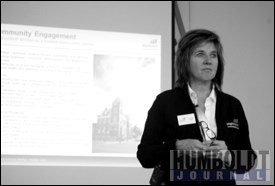During their information session last Tuesday, BHP Billiton gave Humboldt residents another update on their progress and future plans for the Jansen mine.
"We've made serious progress in surface and sub-surface areas," said Jennifer Koury, vice-president of human resources and community engagement for BHP. "We've already changed the road maps; we've modified and upgraded the roads."
There were about 50 local residents in attendance and another nine representatives from BHP available for answering questions. There were also three gentlemen from ATCO Group.
"We're here because we believe we're going to be here for the next 50 to 75 to 100 years," said Koury. "We know that in the foreseeable future we're going to see a bit of an oversupply (of potash), but eventually demand will overtake that supply requiring our new production."
Some key points mentioned during the presentation were employee ramp-up, improved technology, basic mining processes, priority development areas, and environmental and economic focus points in the surrounding areas.
With regards to improved technology, a video was played explaining in more detail the improved safety and efficiency of the equipment they will be using in the shafts. According to Koury, the headframe has already been safely installed. It is almost 100 meters tall and consists of 5000 tonnes of steel. She also talks a little bit about the apparatus being used in the mineshafts.
"This is the first time this technology has been applied to sink a mine shaft in this area," said Koury. "We really did select this equipment for safety reasons. There are no personnel on the cutting bench when the equipment is running. This is fully automated."
The slides further illustrated information statistics such as the company's core demand drivers for potash: a growing global population, greater economic prosperity, and changing food consumption patterns.
"China's middle class is starting to demand a higher quality food like protein which increases the demand for potash," said Koury. "We believe that the demand combined with our financial and technical capabilities as a company and the resource base in Saskatchewan will be sufficient to build this business as that fifth pillar."
(The fifth pillar Koury mentioned pertains to the new addition of potash. The other four pillars are iron-ore, petroleum, copper, and coal.)
The slide presentation went on to depict a map illustrating where the priority development areas were located. Those areas included Wolverine, Burr, Jansen, Young, Boulder-Nokomis, Holdfast, Regina, and Melville.
It also graphed out a steady increase of employees over the next few years, including a spike once the mine actually opens.
"Our construction worker camp is up and running. We commissioned 600 beds and we've decommissioned our camp in Lanigan," said Koury. "It will be one of the best appointed camps in Canada."
The living arrangements will include 2,586 beds, four main dining areas, a gym, a theatre, a golf simulator, squash courts, and a medical clinic. Once the construction is complete, employees will be expected to live in the local communities around Jansen.
"We'll be putting one per cent of our pre-tax profits into community programs," said Koury. "We'll be supporting local planning, housing strategies, community attractiveness, and development activities."
She also touched briefly on the company's infrastructure, including their partnerships with SaskWater, SaskPower, TransGas, and SaskTel. She talked about the dynamic modeling structure and how the company has developed a reliable supply chain.
The supply chain will consist of six stages: the mine, product storage/load out, rail transport, port storage, ship loading, and the vessel, which is the end customer.
Finally, Koury explained a little bit about the company's environmental efforts, such as relocating indigenous toads to nearby farmers' fields and communicating with First Nations communities regarding ecological impacts. They have also implemented an environmental management plan that includes a wetland habitat compensation plan.
"Components are developed as required to meet the needs of the project activities and we're working with the government," said Koury. "We're measuring things we're doing along the way."
The presentation was concluded with questions from residents.

.png;w=120;h=80;mode=crop)


